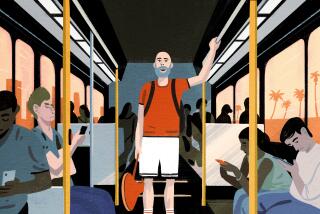Greyhound Journey Is a Real Trip
Among life’s many experiences, few can be more humbling than a ride aboard a Greyhound bus. It is transportation of last resort: a cramped, noisy, slow, smelly way to get from point A to point Z with stops at points B through Y.
I am convinced that only two kinds of people ride long-distance, scheduled buses.
There are those who are so desperately poor that the dollars scrimped by long hours of confinement can pay for a couple more days of meals or enough to cover the rent.
And there are those who are simply stuck. The fog shuts the airport, the rent-a-car agency lot runs out of cars or the weather is so lousy that no one--except a Greyhound bus driver--would dare drive.
My reason was that the Amtrak train I was supposed to catch was running, in Amtrak parlance, “eight to 10 hours late,” which means 10 hours late. And without my presence at home, I was assured, the Christmas ham would grow cold, and unopened presents would lie mournfully under the tree.
Point A was Yuma, Ariz., where I had visited my girlfriend’s family. Point Z was Long Beach by way of Calexico, El Centro, San Diego, Oceanside, El Toro and Westminster. My tour of the Imperial Valley, followed by the drive up the coast, which included two layovers of an hour each, were crammed into eight butt-numbing hours.
It started at 6:30 a.m. on Christmas. Still darkened, the streets of old downtown Yuma were empty of even the few denizens who normally mill around an abandoned agricultural inspection station.
I wrestled my bag into the warmth of what was apparently one of the newer buses in the fleet. This was my first Greyhound ride since about a decade ago when I was working a $200-a-week job in Las Vegas and used to visit Southern California on weekends. In a quick look around the coach, I could tell a few things had changed.
The overhead racks were replaced by white plastic storage bins like those found on jetliners. The only difference was that on the bus, the bin doors pop open and clatter with every lane change or turn. The light blue cloth seats with a gold stripe to which I was accustomed had been replaced by burgundy seats, like those once found on TWA jets.
Both of these changes were apparently wrought by Greyhound’s long fixation on airlines. Even the drivers get in the act, delivering spiels over the bus’s loudspeaker that sometimes seem to lack only the cruising altitude.
But as I settled into my seat, I realized how many things remained unchanged. The air--and by the end of the ride, the people and their baggage--smelled of a sickening perfume odor, presumably disinfectant, diesel exhaust or a mixture of both.
And then there were the passengers. Overnight or early morning buses invariably have the party crowd in back--kind of an all-night live version of the Larry King show--and wailing babies and their cooing mothers in front. Sandwiched between is a determined knot of older women and men who nap despite the constant commotion.
Every bus has at least one crazy person. No mere eccentric or fringe character will do. I’m talking about an out-and-out loony.
Our particular wacko was a young, dark-haired man who paced the aisle handing out religious tracts. Nothing unusual about that. It was Christmas, after all. However, he never stopped talking to an invisible stranger who, judging from the young man’s fixed gaze, sat about three feet in front of him.
I was interested to find out who this mystery friend might be, but that would have meant making eye contact. And one of the first rules of Greyhound travel is to never make eye contact with the crazy person. Otherwise, he may hold a three-way conversation with you and his friend for the next 300 miles.
The sun broke over the mountains, flooding my side of the bus in its warmth. The babies wailed and their mothers tried to hush them. The conversation in the back of the bus shifted alternately from the scourge of drug use to its pleasures.
I tried to join the older crowd amidships in catching some shut-eye, but gave up after deciding they probably learned the art of deep slumber during the bombing of London.
The engine growled and the towns flashed by. In San Diego, I was joined in my seat by a peach-fuzzed Marine sergeant en route to Camp Pendleton. He sat rigid, eyes straight ahead and silent as I thumbed through the morning paper.
“Anyone for El Toro?” the driver inquired meekly, as if he were crossing his fingers in hopes that he could skip a stop. No such luck, and off the freeway we came again. In Westminster, we lost a couple more off the dwindling passenger list but picked up an eager middle-aged couple oblivious to the bleary eyes around them.
Soon--although it didn’t seem like “soon” at the time--I was back in Long Beach. The bus pulled into the terminal in early afternoon. I hopped off, reveled in the sea breeze and momentarily relished the realization that my long journey had come to an end. Well, almost. Now how do you catch the city bus home?
More to Read
Sign up for The Wild
We’ll help you find the best places to hike, bike and run, as well as the perfect silent spots for meditation and yoga.
You may occasionally receive promotional content from the Los Angeles Times.






